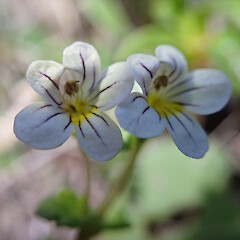Euphrasia cheesemanii
Family
Orobanchaceae
Flora category
Vascular – Native
Endemic taxon
Yes
Endemic genus
No
Endemic family
No
Structural class
Herbs - Dicotyledons other than Composites
NVS code
The National Vegetation Survey (NVS) Databank is a physical archive and electronic databank containing records of over 94,000 vegetation survey plots - including data from over 19,000 permanent plots. NVS maintains a standard set of species code abbreviations that correspond to standard scientific plant names from the Ngä Tipu o Aotearoa - New Zealand Plants database.
EUPCHE
Current conservation status
The conservation status of all known New Zealand vascular plant taxa at the rank of species and below were reassessed in 2017 using the New Zealand Threat Classification System (NZTCS) – more information about this can be found on the NZTCS website. This report includes a statistical summary and brief notes on changes since 2012 and replaces all previous NZTCS lists for vascular plants.
Please note, threat classifications are often suggested by authors when publications fall between NZTCS assessment periods – an interim threat classification status has not been assessed by the NZTCS panel.
- Conservation status of New Zealand indigenous vascular plants, 2017 . 2018. Peter J. de Lange, Jeremy R. Rolfe, John W. Barkla, Shannel P. Courtney, Paul D. Champion, Leon R. Perrie, Sarah M. Beadel, Kerry A. Ford, Ilse Breitwieser, Ines Schönberger, Rowan Hindmarsh-Walls, Peter B. Heenan and Kate Ladley. Department of Conservation. Source: NZTCS and licensed by DOC for reuse under the Creative Commons Attribution 4.0 International licence.
2017 | Not Threatened
Previous conservation statuses
2012 | Not Threatened
2009 | Not Threatened
2004 | Not Threatened
Distribution
Endemic. South Island, north-west Nelson to the Brunner Range and Mount Mantell.
Habitat
Montane to subalpine wet places and edges of swamps.
Detailed description
Slender succulent annual herb 50-100 mm high with lax ascending bifariously pubescent branches up to 200 mm or more long. Leaves sessile, distant, 4-10 x 3-8 mm, ovate to ovate-oblong with 2-4 pairs of obtuse to subacute crenations and obtuse tip, submembranous, subglabrous or finely white-pubescent, margins and veins below thickened and scabrid or setose with fine stiff hairs. Flowers few and usually distant towards the upper part of the branches, pedicels slender, white-pubescent and sometimes also glandular-hairy, up to 30 mm long and usually much longer than leaves, usually more or less curved in fruit. Calyx 3-4 mm long, subevenly divided about ⅓ way into obtuse lobes with margins and midribs thickened and white-pubescent, sometimes glandular hairs also present. Corolla white, 8-12 mm. long; tube much greater than calyx; lobes of lower lip 2.5-3 mm. wide, entire. Anthers golden yellow, margins hairy, awns unequal. Capsule equal to or greater than calyx, 3-4 x 3-3.5 mm, obovate to suborbicular, finely setose at apex; seeds 2 per locule or 1 by abortion, approximately 2 mm long.
Similar taxa
Forms of Euphrasia australis with obtuse leaf-teeth and calyx-lobes are superficially very similar to E. cheesemanii but differ in pubescence, anther-characters and number of ovules.
Flowering
December - February
Flower colours
White
Fruiting
January - March
Life cycle
Seeds is dispersed by wind and possibly water and ballistic projection (Thorsen et al., 2009).
Etymology
euphrasia: Eye-medicine
cheesemanii: Named after Thomas Frederick Cheeseman (1846 - 15 October 1923) who was a New Zealand botanist and naturalist who, in 1906, produced The Manual of the New Zealand Flora.
Attribution
Fact sheet prepared for NZPCN by M.D. Ward (3 November 2020) Description adapted from Allan (1961).
References and further reading
Allan, H. H. 1961. Flora of New Zealand. Volume 1. Wellington: Government Printer. Pages 857-858.
Thorsen, M. J.; Dickinson, K. J. M.; Seddon, P. J. 2009. Seed dispersal systems in the New Zealand flora. Perspectives in Plant Ecology, Evolution and Systematics 11: 285-309
NZPCN Fact Sheet citation
Please cite as: Ward, M.D. (Year at time of access): Euphrasia cheesemanii Fact Sheet (content continuously updated). New Zealand Plant Conservation Network. https://www.nzpcn.org.nz/flora/species/euphrasia-cheesemanii/ (Date website was queried)






